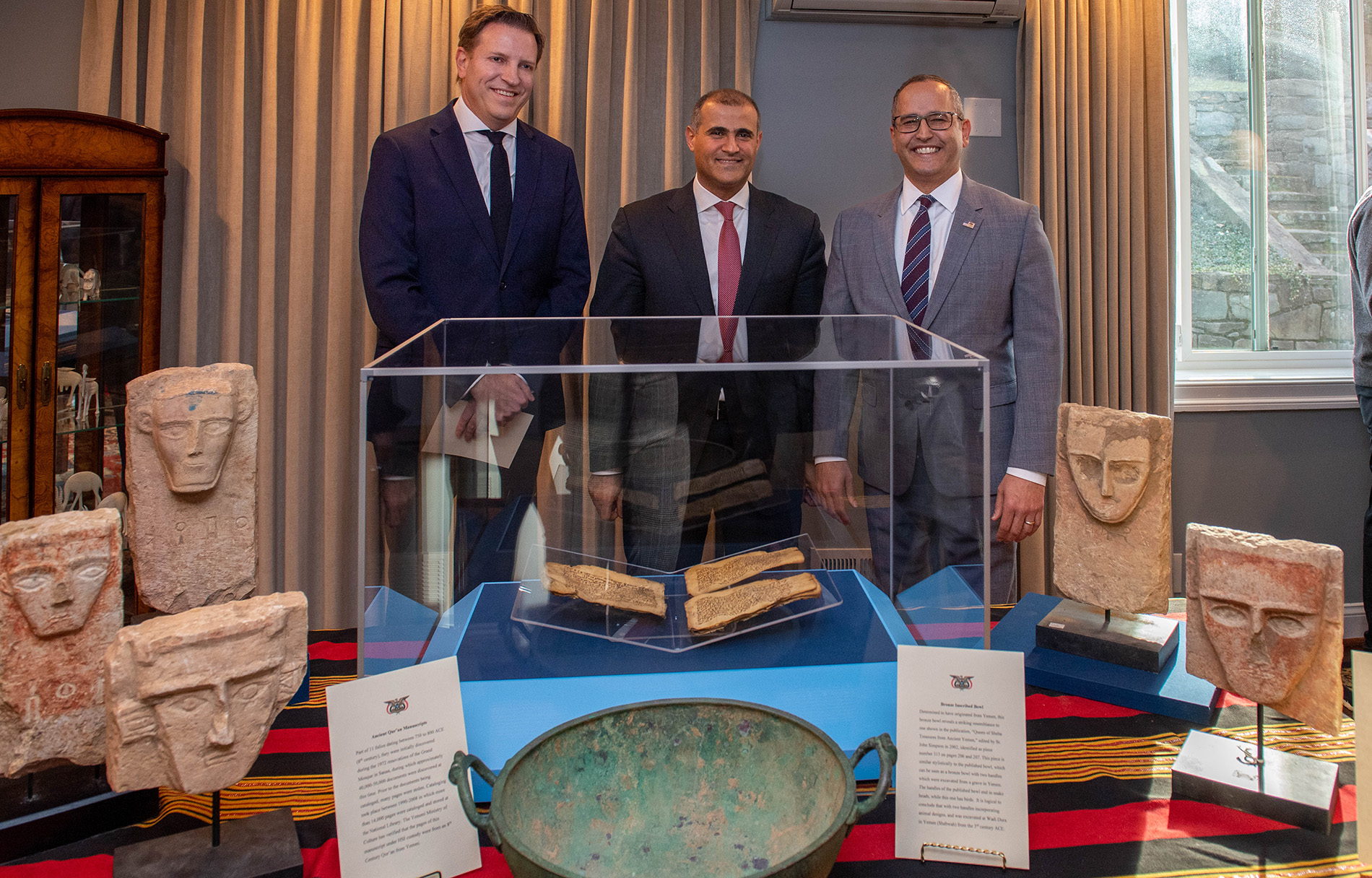Archived Content
In an effort to keep ICE.gov current, the archive contains content from a previous administration or is otherwise outdated. This information is archived and not reflective of current practice.
HSI, CBP, Department of State, US Attorney’s Office, Smithsonian Institution conduct repatriation of stolen cultural property to Yemeni Embassy
WASHINGTON – Today, U.S. Immigration and Customs Enforcement’s Homeland Security Investigations (HSI), alongside representatives from the U.S. Attorney’s Office for the Eastern District of New York, Smithsonian Institution, the U.S. Department of State, and U.S. Customs and Border Protection conducted a repatriation ceremony hosted by the Yemeni Ambassador returning 77 pieces of stolen cultural property seized by U.S. law enforcement officials to the Republic of Yemen Government. The artifacts included 64 relief carved stone heads, a bronze inscribed bowl, a stone Funerary Stele from around the 1st century BCE, and 11 pages from an 8th century Quran.
“Homeland Security Investigations is honored to stand with our partners including U.S. Customs and Border Protection, the U.S. Department of State, the U.S. Attorney’s Office for the Eastern District of New York, the Smithsonian Institution, and Ambassador Mohammed Al-Hadhrami to return these treasured antiquities to the people of Yemen,” said HSI Acting Executive Associate Director Steve K. Francis. “Looted cultural property, art, and antiquities are often assigned a dollar value in the marketplace; however, the historical and cultural significance of these artifacts extends beyond any monetary value. HSI is proud to have played a role in the recovery and return of this priceless cultural heritage back to the Yemeni people so they can enjoy it for generations to come.”
The 64-relief carved stone heads were forfeited to the United States in connection with an Eastern District of New York civil forfeiture action related to the April 2012 guilty plea of an antiquity smuggler, Mousa Khouli, aka Morris Khouli. As alleged in the government’s forfeiture complaint, these 64 pieces were smuggled into the United States from the United Arab Emirates. The artifacts were associated with correspondence and invoices containing multiple inconsistencies and were seized from the garage of Khouli’ s Brooklyn, New York, residence, and New York gallery.
“This repatriation of forfeited antiquities to Yemen is a historic, happy culmination to our Office’s civil forfeiture action and a testament to our commitment to ensuring to the global community that we will continue to do all we can to prosecute bad actors who do not share our respect for cultural history,” stated United States Attorney Breon Peace.
“On behalf of the Government of Yemen, I express my deep gratitude to the U.S. Government, to HSI, the Department of State and U.S. Attorney’s Office for the Eastern District of New York for all efforts exerted in the retrieval and return of these Yemeni artifacts,” said Ambassador Mohammed Al-Hadhrami. “Ever since the Houthis’ coup in Yemen, our heritage and history have been under attack. The Embassy of Yemen will continue its close engagement with the U.S. Government in pursuit of the restitution of Yemen’s stolen cultural heritage and property. I also affirm my substantial appreciation to the Smithsonian Institution for agreeing to temporarily hold these antiquities until they are fully repatriated back to Yemen in the future.”
One of the primary goals of the HSI Cultural Property, Art, and Antiquities (CPAA) program is to protect and preserve the world’s cultural heritage and knowledge of past civilizations. CPAA conducts training and outreach, supports cultural property investigations, and enhances international relations by working with foreign governments and citizens to return their nation’s looted cultural heritage and stolen artwork.
The United States returns stolen cultural property pursuant to U.S. law and international commitments. The United States and Yemen are States Parties to the 1970 United Nations Educational, Scientific and Cultural Organization (UNESCO) Convention on the Means of Prohibiting and Preventing the Illicit Import, Export, and Transfer of Ownership of Cultural Property. Article 7 of the UNESCO Convention states that States Parties shall take appropriate steps to recover and return cultural property imported after entry into force of this Convention in both States concerned. Additionally, Article 13 declares that States Parties shall ensure their competent services cooperate in facilitating the earliest possible restitution of illicitly exported cultural property to its rightful owner.
Since 2009, the HSI/CPAA program has partnered with the U.S. Department of State’s Cultural Heritage Center and the Smithsonian Institution to train special agents within HSI, as well as the FBI, customs officers, and prosecutors in current techniques, while educating them on trends for conducting criminal investigations and properly handling cultural property. Since that time, HSI/CPAA has repatriated over 20,000 objects to more than 40 countries worldwide.
While this is a significant number, HSI notes that a single artifact/object recovered and repatriated is a success in preserving cultural heritage. In addition to its work facilitating repatriations, HSI CPAA continues to execute its mission to investigate leads, work alongside partners, and pursue individuals and networks engaged in the smuggling of cultural property, art, and antiquities.
In fiscal year (FY) 2022, HSI’s International Operations repatriated cultural property to more than 15 countries, including France, India, Iraq, Italy, and Mali on 20 different occasions. Repatriated items included prehistoric fossils, cuneiform tablets, religious artifacts, and artwork stolen from Jewish communities during the Holocaust.
Follow us on Twitter @HSI_HQ to learn more about HSI’s global missions and operations.
HSI is the principal investigative arm of DHS, responsible for investigating transnational crime and threats, specifically those criminal organizations that exploit the global infrastructure through which international trade, travel, and finance move. HSI’s workforce of more than 8,700 employees consists of more than 6,000 special agents assigned to 237 cities throughout the United States, and 93 overseas locations in 56 countries. HSI’s international presence represents DHS’s largest investigative law enforcement presence abroad and one of the largest international footprints in U.S. law enforcement.




